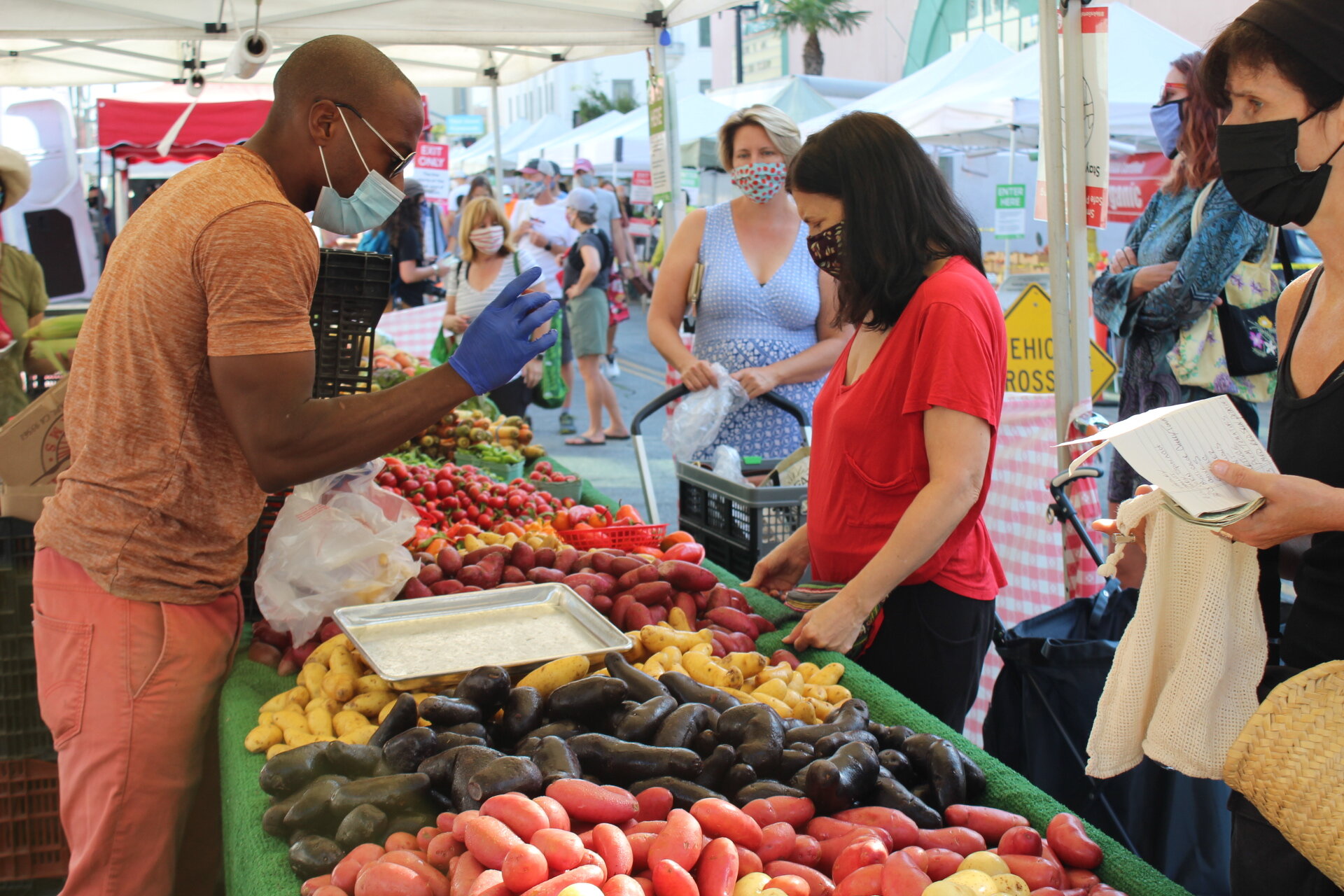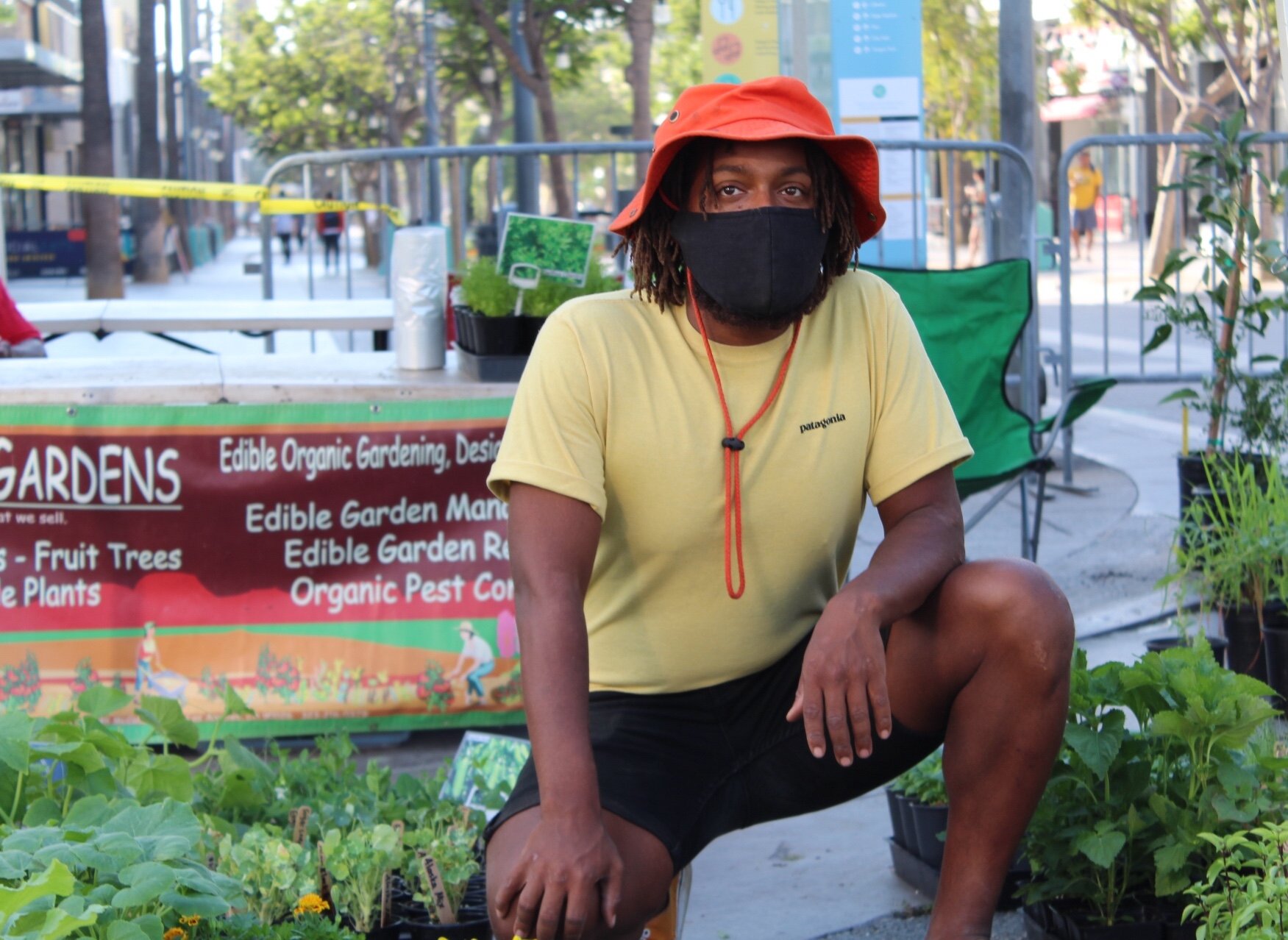A New Normal for California's Local Farmers Markets
Victor Gomez of Monak Farms at the Santa Monica Farmers Market on Saturday, September 5, 2020, unpacking produce. A “For Lease” sign is seen in the back. Santa Monica, Calif. (Johaira Dilauro / The Corsair)
Even during these unparalleled times, the line to get into the Santa Monica Farmers Market begins to build and grow robust by as early as 6:45 a.m. Restaurant owners, chefs, and patrons alike patiently wait in a line - six feet apart with masks on - for up to an hour to go into the Farmers Market.
Laura Garcia, a Venice local who has been an advocate of fresh sustainable food since long before the pandemic, regularly commits to the wait time.
“I want to help the local economy. The idea of having food flown in from halfway across the world is horrible for the environment," Garcia said. "The weather is so perfect for all of our foods, so why not have something that is grown 20 miles away as opposed to something that is picked early and processed to make it look fresh?”
The Santa Monica Farmers Market has been a well-respected and highly-trafficked market since it was established in 1991, supplying fresh produce, flowers, and animal products to some of the most well-known and highly-acclaimed restaurants in Los Angeles. Farms come in from all over California to hold a spot at the exceedingly competitive market.
Kimberly Duenas, an employee from Millikan Family Farms in Santa Barbara, has seen people that are both pro-mask and anti-mask at the Farmers Market. Most people seem to be adjusting well to safety measures of staying six feet apart, wearing masks and gloves, and following barriers and signage; many are more supportive and grateful nowadays.
“More people are coming out and saying that they’ve never been to the farmers market before," Duenas said. "They always had this preconceived notion that farmers' markets were too expensive. Now they live and eat healthier with local food right at their fingertips."
Amidst a global pandemic and the recent California wildfires, the agricultural industry in general and farmers markets in particular are faced with some dramatic changes, compromised health, low wages, and destruction of crops. Farmworkers - most of whom are undocumented from Latin American countries - that have already endured economic burdens from the pandemic are in no place to turn down work, even if the air quality is declared inimical.
Victor and Araceli Gomez, siblings from Monaka Farms in Paso Robles, have had to accommodate to the pandemic by changing protocol for their farmers and their crops.
“The smoke and air quality is horrible, the wind brought in a layer of fog and dust. We did continue to work because people still needed us and orders needed to be fulfilled even if our health is being compromised," Araceli Gomez said. "There is no other option.”
Victor Gomez described the evolution in his crops as a result of the climate change, “For us, more heat has developed more flavor. The Heirloom tomatoes can get sunburnt on the skin so they don't look as pretty, but they taste great.”
Stories like these are not few and far between; though some of the changes have been life-altering and financially straining, buyers and sellers continue to show up weekly to engage in their ritualistic market practices.
Kathleen Davis, a Santa Monica resident for over 40 years, has been going to the Santa Monica Farmers Market since she settled down in the city. Her shopping experience has been drastically changed by COVID-19 health protocol - especially after she was told "you touch, you buy" by a farmer. She's also grown nostalgic of sellers who she has not seen for months now.
“I miss my favorite florists Jeff and Chulio that have been part of the Farmers Market for over 20 years. They have not returned since the pandemic hit," Davis said.
Logan Williams from Logans Gardens is thriving and sales have skyrocketed since the beginning of the year. Logans Gardens is a family-owned nursery that sells over 1,000 varieties of rare and edible plants. He sees a correlation between the increase of sales and the amount of time people have had on their hands these past several months. “My grandma always gardened, my mom always gardened, but I never did it,” said Williams.
A lot of flexibility is needed as adjustments are ever-changing. The industry itself is in constant question of how to take the next, right action. How do you keep the farmers and patrons safe without compromising sales? How do you create a friendly, low-anxiety environment? Which way do you direct foot traffic, and are outside food and beverages allowed in? All of these are questions that farmers markets are still facing in this new normal.
The Santa Monica Farmers Market is held on Saturday at Arizona and 3rd Avenue and on Wednesday at Arizona and 2nd Street, from 8:00 a.m. to 1:00 p.m, both days.













